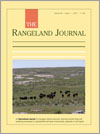RJ15114Cattle landscape selectivity is influenced by ecological and management factors in a heterogeneous mountain rangeland
Cattle selectivity in natural grasslands is one of the most important aspects to understand herbivore behaviour, and accordingly, a key factor necessary for improving livestock production in rangelands. We found that cattle landscape selectivity was mainly driven by the cover of short plants. Strength of selectivity and associated grazing distribution patterns were different depending on paddock management and characteristics. Effective methods of changing animal distribution involve paddock design and manipulation of forage types, while the role of stocking rate remains controversial.




